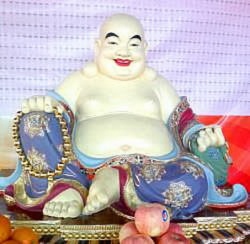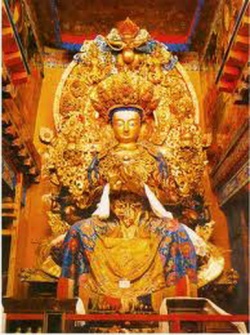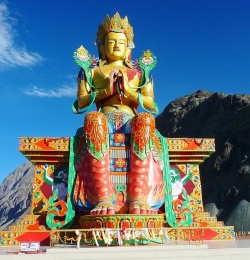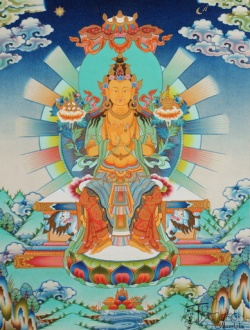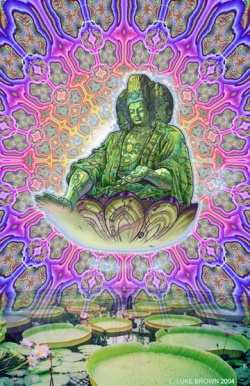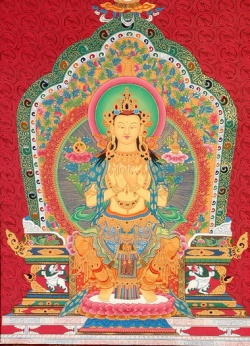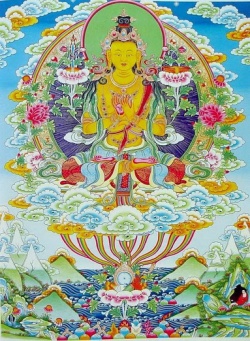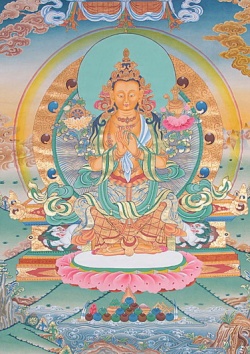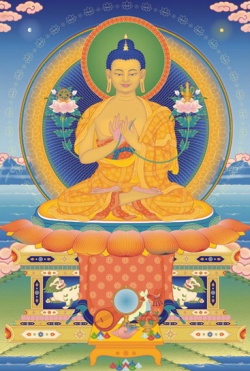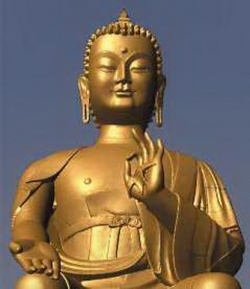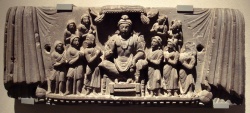Maitreya Buddha
Buddha Maitreya is the Buddha of the future, also known as the Laughing Buddha, is the one to follow up the historical Buddha Sakyamuni.
He waits in the Tusita heaven for the moment he is to appear on earth as the Buddha of the fifth world cycle.
At present he is considered as one of the dhyani-Bodhisattvas, the creators of the universe.
In the future he will be like Sakyamuni, a mortal manusi Buddha who lives on earth for a while in order to teach mankind the doctrine.
Maitreya, 'the loving one', is widely worshipped in the Himalayan regions.
Future History
Shakyamuni Buddha predicted that due to the inevitable degeneration of the times, his own teachings would last just five thousand years before disappearing from this world.
People will grow more and more immoral and their lifespan will gradually decrease, as will their health, stature and fortune.
While such delusions as miserliness, hatred and jealousy gain strength, the world will go through prolonged periods of famine, disease and continuous warfare until it eventually resembles a vast battlefield of graveyard.
Thereupon Maitreya will appear, not in his fully evolved buddha form, but as a person of regal bearing, very handsome and taller than those around him.
On seeing this unusual being, people will be filled with wonder and faith, and will ask how he came to have such an attractive appearance.
Maitreya will reply that this is due to his practice of patience, avoiding giving harm to others, and if others will also abide in love and tolerance, they could become similar to him.
Maitreya's appearance will mark a great turning point in the fortunes of this world. As more and more beings follow his example, their store of merit, and consequently their lifespan, will increase.
Eventually people will live in health for such a long time that the sufferings of old age and death will scarcely be known.
At that time, their observance of morality will grow lax as people become more and more involved in the pleasures of their existence. With this laxity will come another gradual shortening and degeneration of their lifespan until eventually beings once again will become suitable ripe to take sincere interest in the spiritual path.
When the human lifespan as increased again to many thousands of years, and when the planet will be entirely dominated by a benevolent wheel-turning sovereign (Chakravartin) named Shankha, it is at this time that Maitreya Buddha will descend from the Tushita buddha field (devaloka) where he now resides, to appear in this world as the fifth founding Buddha of this world age.
Maitreya will be born the son of a Brahmin priest, and will renounce the world and attain enlightenment in a single day, not requiring six long years.
The world in this time will be politically neutralised, and therefore the warrior class and its martial virtues will be obsolete.
Thus he will be born among the intellectuals, the priests, and his teaching will bring the gentler emotions to the fore.
His teachings will not deviate from that of previous Buddhas, except for an interesting tradition that he will not teach any esoteric Tantras (most likely hinting that Maitreya's mission will in general be more effective than Shakyamuni's).
This does not show a difference in the perfection of liberative techniques of the two Buddhas, rather a difference in the evolutionary stage of the human beings on the planet (Shakyamuni Buddha taught at a time of violence and widespread militarism,
and had to turn to the martial qualities of toughness, ascetism and determination toward the pursuit of enlightenment.
Shakyamuni Buddha also predicted that those who followed his teachings would be reborn in the first circle of Maitreya's entourage and would be able to complete the spiritual path under Maitreya's guidance.
The Maitreyavyankarna or "The Prophecy Concerning Maitreya"
translated by Edward Conze in his Buddhist Scriptures (Penguin Books, 1959), pages 238-242.
Sariputra, the great general of the doctrine, most wise and resplendent, from compassion for the world asked the Lord:
'Some time ago you have spoken to us of the future Buddha, who will lead the world at a future period, and who will bear the name of Maitreya.
I would now wish to hear more about his powers and miraculous gifts. Tell me, O best of men, about them!'
The Lord replied: 'At that time, the ocean will lose much of its water, and there will be much less of it than now. In consequence a world-ruler will have no difficulties in passing across it.
India, this island of Jambu, will be quite flat everywhere, it will measure ten thousand leagues, and all men will have the privilege of living on it.
It will have innumerable inhabitants, who will commit no crimes or evil deeds, but will take pleasure in doing good.
The soil will then be free from thorns, even, and covered with a fresh green growth of grass; when one jumps on it, it gives way, and becomes soft like the leaves of the cotton tree.
It has a delicious scent, and tasty rice grows on it, without any work.
Rich silken, and other fabrics of various colours shoot forth from the trees.
The trees will bear leaves, flowers and fruits simultaneously; they are as high as the voice can reach and they last for eight myriads of years.
Human beings are then without any blemishes, moral offences are unknown among them, and they are full of zest and joy.
Their bodies are very large and their skin has a fine hue.
Their strength is quite extraordinary.
Three kinds of illness only are known -- people must relieve their bowels, they must eat, they must get old. Only when five hundred years old do the women marry.
The city of Ketumati will at that time be the capital. In it will reside the world-ruler, Shankha by name, who will rule over the earth up to the confines of the ocean; and he will make the Dharma prevail.
He will be a great hero, raised to his station by the force of hundreds of meritorious deeds.
His spiritual advisor will be a Brahmin, Subrahmana by name, a very learned man, well versed in the four Vedas, and steeped in all the lore of the Brahmins.
And that Brahmin will have a wife, called Brahmavati, beautiful, attractive, handsome, and renowned.
Maitreya, the best of men, will then leave the Tushita heavens, and go for his last rebirth into the womb of that woman. For ten whole months she will carry about his radiant body.
Then she will go to a grove full of beautiful flowers, and there, neither seated nor lying down, but standing up, holding on to the branch of a tree, she will give birth to Maitreya.
He, supreme among men, will emerge from her right side, as the sun shines forth when it has prevailed over a bank of clouds.
No more polluted by the impurities of the womb than a lotus by drops of water, he will fill this entire Triple world with his splendour.
As soon as he is born he will walk seven steps forward, and where he puts down his feet a jewel or a lotus will spring up.
He will raise his eyes to the ten directions, and will speak these words: "This is my last birth. There will be no more rebirth after this one.
Never will I come back here, but, all pure, I shall win Nirvana!"
And when his father sees that his son has the thirty-two Marks of a Superman, and considers their implications in the light of the holy mantras, he will be filled with joy, for he will know that, as the mantras show, two ways are open to his son: he will either be a universal monarch, or a supreme Buddha.
But as Maitreya grows up, the Dharma will increasingly take possession of him, and he will reflect that all that lives is bound to suffer.
He will have a heavenly voice which reaches far; his skin will have a golden hue, a great splendour will radiate from his body, his chest will be broad, his limbs well developed, and his eyes will be like lotus petals. His body is eighty cubits high, and twenty cubits broad.
He will have a retinue of 84,000 persons, whom he will instruct in the mantras.
With this retinue he will one day go forth into the homeless life.
A Dragon tree will then be the tree under which he will win enlightenment; its branches rise up to fifty leagues, and its foliage spreads far and wide over six Kos.
Underneath it Maitreya, the best of men, will attain supreme enlightenment, there can be no doubt on that.
And he will win his enlightenment the very same day that he has gone forth into the homeless state.
And then, a supreme sage, he will with a perfect voice preach the true dharma,
which is auspicious and removes all ill, i.e. the fact of ill, the origination of ill, the transcending of ill, and the holy eightfold path which brings security and leads to Nirvana.
He will explain the four Truths, because he has seen that generation, in faith, ready for them, and those who have listened to his Dharma will thereupon make progress in the religion.
They will be assembled in a park full of beautiful flowers, and his assembly will extend over a hundred leagues.
Under Maitreya's guidance, hundreds of thousands of living beings shall enter upon a religious life.
And thereupon Maitreya, the compassionate teacher, surveys those who have gathered around him, and speaks to them as follows:
"Shakyamuni has seen all of you, he, the best of sages, the saviour, the world's true protector, the repository of the true Dharma.
It was he who has set you on the path to deliverance, but before you could finally win it you have had to wait for my teaching.
It is because you have worshipped Shakyamuni with parasols, banners, flags, perfumes, garlands, and unguents that you have arrived here to hear my teaching.
It is because you have offered to the shrines of Shakyamuni unguents of sandalwood, or powdered saffron, that you have arrived here to hear my teaching.
It is because you have always gone for refuge to the Buddha, the Dharma, and the Sangha, that you have arrived here to hear my teaching.
It is because, in Shakyamuni's dispensation, you have undertaken to observe the moral precepts, and have actually done so, that you have arrived here to hear my teaching.
It is because you have given gifts to the monks -- robes, drink, food, and many kinds of medicines -- that you have arrived here to hear my teaching.
It is because you have always observed the sabbath days that you have arrived here to hear my teaching.
And Shakra, the thousand-eyed, the replendent king of the gods, rejoiced greatly, saluted the leader of the world, and praised him as follows:
"Homage to you, O noblest of men! Homage to you, the best of all men! Have pity on the multitude, O Lord!"
And also Mara, the greatly powerful, will be there, and he also will salute the leader of the world, and praise him.
And, surrounded by his retinue of gods, Brahma also will proclaim the true Dharma with his heavenly voice.
And the entire world shall be crowded with Arhats, whose outflows have dried up, who have got rid of their faults, who have shaken off all the bonds which tie them to becoming.
Joyously the gods, men, Gandharvas, Yakshas, and Rakshasas worship the teacher, and so do the mighty Dragons.
They also will lose their doubts, and the torrent of their cravings will be cut off: free from all misery they will manage to cross the ocean of becoming; and, as a result of Maitreya's teaching, they will lead a holy life.
No longer will they regard anything as their own, they will have no possessions, no gold or silver, no home, no relatives! But they will lead a holy life of chastity under Maitreya's guidance.
They will have torn the net of the passions, they will manage to enter into the trances, and theirs will be an abundance of joy and happiness; for they will lead a holy life under Maitreya's guidance.
For 60,000 years Maitreya, the best of men, will preach the true Dharma, which is compassionate toward all living beings, and when he has disciplined in his true Dharma hundreds and thousands of millions of living beings, then that leader will at last enter Nirvana.
And after the great sage has entered Nirvana, his true Dharma still endures for another ten thousand years.
Raise therefore your thoughts in faith to Shakyamuni, the Conqueror!
For then you shall see Maitreya, the perfect Buddha, the best of men!
Whose soul could be so dark that it would not be lit up with a serene faith when he hears these wonderful things, so potent for future good!
Those therefore who long for spiritual greatness, let them show respect to the true Dharma, let them be mindful of the religion of the Buddhas!
Ketumati: The City Of Wonders
In that city of Ketumati, not a single person will live in a hut made of wood and leaves. Everyone will live in palaces made of the seven types of gems.
In all of Jambuudviipa, no one will engage in cultivation, in trade or in any other profession; and no one will suffer from hunger.
In suitable places of the earth, a self-generating rice paddy will appear which will bear pearl-like grains with a fragrance but no chaff.
When the harvest of one of those plants is taken, sixteen amunus (a measure of volume equal to approximately four bushels) and eight laas (a measure of volume equal to approximately one bushel) will remain after two thousand two hundred and seventy-two carts have been loaded!
When this rice is cooked in a golden bowl on a hearth of gems on a fire arising from jotirasa (gems), everyone will consume it with tasty meats and other curries.
When people feel the need to relieve themselves, a blue cloud will rush up to them and provide a cover.
Instantly, a pit will appear in the ground.
When they have answered nature's call, the pit will disappear and a pond of water will take its place.
When they have washed in that pond, the cloud will disappear.
Thus the city of Ketumati will be like a heaven.
As it has been said:
There will be a glorious city called Ketumatii inhabited by very rich people where there will be beautiful houses, pandals and gates which will shine like a heavenly city.
Jambuudviipa: The Wonderland
At that time, Jambuudviipa with all its [area of] ten thousand yojanas (a measurement approximately equal to seven miles) will be similar to the kingdom of Ketumatii, being as prosperous as a wedding house in season.
In these kingdoms, men and women will wash and bathe in ponds with banks of white sands upon which stairs made of the seven types of gems lead down.
These ponds will be frequented by swans and other birds and will always be covered by five types of water lilies. People will wear heavenly scents and creams, wreaths of divine flowers, selected ornaments and adorn themselves with garments and clothes freely given by the kalpa v.rk.sas (heavenly wishing trees which appear during the first phases of a kalpa during the time of an enlightened buddha that provide for all human material wants).
They will enjoy the taste of heavenly-scented rice, sit and lie on comfortable beds with heavenly bedspreads, sleep while listening to music and watch the dancing of artists who resemble the artists in heaven.
They will awaken from sleep hearing music and see their wealth and comforts by the light of lamps burning with scented oil.
They will be especially happy when they see their great wealth of cash, grains, elephants, horses, servants and labourers.
As their minds will be full of happiness, they will enjoy this life full of luxury and comfort.
None of them will suffer from the ninety-eight or ninety-nine types of illness nor from the two hundred and three accidents.
Their bodies will be as healthy as the gods.
As it has been said:
The people of Jambuudviipa will be rich and prosperous.
They will always be happy and gay, peaceful in mind, enjoying the five types of comforts, adorning their bodies with various ornaments which, devoid of all ailments, will shine like the bodies of the gods.
Maitreya's Invitation To Buddhahood
At that time, when the human world is more comfortable that the heavens and when men will live for eighty-four thousand years, all the
'Sakras,
Brahmaas,
Suyamas,
Santu.sitas and
Sunirmitas,
all the brahmanaas and devas of the ten thousand universes which surround this fortunate galaxy (Mangul-Sakvala) of ours, will gather and approach Bodhisattva Maitreya living in the Tusita heaven and invite him as follows:
'O Great Lord, now is the time for you to become a Buddha.'
Then the great bodhisattva [will say]: 'Time, country, continent, family and mother; having observed these five, the buddhas will be born.'
Bodhisattva Maitreya's Final Birth As Prince Ajita
Thus having looked into these five great matters and having confirmed by the devas that the time is right for him to become Buddha, he will be conceived in the womb of a brahman woman named Brahmawathie, the wife of the brahman Subraahma.na, the chief advisor to the great king Sa.nkha.
Then, after a lapse, he will be delivered from his mother's womb into the hands of Mahaa Brahmaa before a huge gathering of brahmaas and devas of the ten thousand universes.
With the appearance of his thirty-two marks, many miracles will occur and all the universes with mountains such as Cakravaala, Meru and Yugandhara will quake.
Then growing day by day like the waxing moon and with all the glory and prosperity of a child in heaven, he will become a young prince.
By means of the meritorious power of the Bodhisattva Maitreya who will be named Prince Ajita, three palaces called Vardhamaanaka, Siddhaarthaka and Candra, made of the seven types of gems, will arise out of the earth and be his residences for the three seasons.
Each palace will consist of seven stories and on each floor there will be millions of small rooms.
Around each palace there will be seven walls of the seven types of gems.
At the gates of the palaces will be pandals made of variegated gems.
At the edge of the roofs of those palaces will be a golden mesh which will make music similar to that of the five types of instruments. On top of the palaces seven flags made of the seven types of gems will be hoisted.
The whole city will vibrate with the continuous sound of golden chimes attached to the feet of the people.
On the walls of the great palaces, decorative scenes of the following will be clearly visible:
lines of palms,
lions,
elephants,
coaches,
peacocks,
swans,
curlews,
storks,
eagles,
garudas,
naagas,
devas,
brahmaas,
creepers,
trees,
lakes,
oceans,
ships full of gold,
silver and
coral.
Jambuudviipa and other great islands (continents), Ketumati and other great cities, and other cloth paintings shining with the colours of the rainbow.
Daily, showers of heavenly flowers will fall on top of those palaces.
On every floor of those palaces, there will be seven thousand well-decorated chambers, seven thousand thrones made of the Vaiduurya gem, seven thousand parasols with handles made of gems and beds covered by multicoloured sheets.
The pinnacles of the palaces will be made of gold.
Around each palace, rows of elephants, numbering seven thousand in all, dressed up and attired with ornaments, will stand guard with their leader named Chaddanta.
Seven thousand horses, whose leader will be named Valaahaka, will also be fully attired and waiting on guard.
Seven thousand coaches shining like golden mountains will fly flags made of gems.
On each floor, seven thousand dancing girls will await dressed up and ready to dance.
The leader of the dancing girls will be Queen Candra-mukhii, who will be one of a kind, unsurpassed in her beauty. She will shine with the sixty-four kinds of feminine qualities.
She will be not too tall, nor too short, nor too thin, nor too fat, nor too dark, nor too fair. In her exquisite beauty, she will be more divine than human.
Sandalwood scent will issue from her body and the scent of water lilies from her mouth.
The glow of her body will cover an area of twelve riyan (a measurement of length approximately one cubit or half a yard). Her body will be as soft as well-cleaned cotton.
She will have the five qualities of beauty:
beauty of bones, beauty of muscles, beauty of complexion, beauty of hair and beauty of age.
This will be her final rebirth as she will have completed all the necessary merits to become an arhant and attain nirvana.
As it has been said:
Having great amounts of merit earned over a vast period of time, being extremely beautiful, soft and gentle, having a pretty face like the moon, the wife of the bodhisattva will also be in her final birth.
The son of the mahaabodhisattva will be named Prince Brahmavardhana and will be the eldest of one thousand sons.
In each palace there will be four pits of treasure one yojana in length, one yojana in width and one yojana in depth.
At the four corners of the palace, four kalpa v.rk.sas will arise up out of the ground and bear all kinds of clothes and ornaments. Mahaabodhisattva Ajita, accompanied by a retinue of women wonderfully attired and replete with feminine grace, will enjoy the five types of worldly comforts for a period of one thousand years in each of these mansions according to the season. As it has been said:
The residential mansions of that bodhisattva will have floors made of gems, walls decorated with paintings, garlands of scented flowers hanging here and there, and will be full of pretty maidens dancing and singing.
Because of the power of Bodhisattva Ajita, all the kings in the eighty-four thousand kingdoms of Jambuudviipa led by the cakravartin Sa.nkha together with multitudes of human and divine kings, will approach him and say:
'Lord, we have all come to serve you.'
The bodhisattva will reply:
'I have enormous numbers of attendants and followers here.
You may all go back to your own palaces and rule your countries [from there].'
And so he will allow the kings and gods to go back.
About eighty-four million ministers who were formerly the bodhisattva's companions in heaven and now born into the various families of the city of Ketumatii will continuously surround him as his guards.
Ajita's Great Renunciation
The great bodhisattva, enjoying all comforts similar to heaven's will live a lay life for eighty thousand years until one day on his way to the royal park, the devas will create the figures of an old man, a sick man and finally a corpse.
After seeing these three signs and becoming disillusioned with samsaara, he will give up the three-fold intoxications of being obsessed with youth, health and life.
Upon seeing a fourth figure conjured up by the devas, the figure of a renouncer, he will decide to become a bhikkhu. Having engaged in sporting activities in the royal park and returning to the city on a road decorated by the devas, he will go up to the fourth floor of his mansion,
enter his chamber brightly illuminated and scented by golden lamps and enjoy physical rest for seven days while engaging in pradhaanavirya (this is the great resolution of a bodhisattva not to leave his seat under the bodhi tree, even if his body suffers to the point of deterioration, until he has gained enlightenment).
On the full moon day of Vesak when all buddhas attain buddhahood, and on the day when Queen Candamukhii delivered Prince Brahmavardhana, he will wish to set forth on the great renunciation.
Instantly, all the gods of the ten thousand worlds of this universe will congregate.
In all the eighty-four thousand kingdoms of Jambuudviipa a mighty commotion will ensue as everyone will be saying: 'It is [[Prince} Ajita's]] renunciation, today.'
Then King Sa.nkha, followed by a large crowd of dancers and people, will go up to the golden hall of the bodhisattva.
And remaining various castes and social levels (k.satriyas, braahma.nas, vai'syas and 'sudras), male and female devotees and ordinary people from all countries and states will bring flowers, scents, flags, banners, umbrellas, banana leaves, pots, wreaths and so forth and gather around the palace.
In the sky, innumerable gods will change themselves into tiny figures bearing scented flowers in their hands and will fill the whole of space with sounds of 'sadhu' (an affirmative acclamation meaning roughly 'holy' and/or 'amen') and divine music.
The entire earth will be covered with precious stones, flowers and powders, dropped by the gods and brahmaas watching from Cakravate mountain and other cosmic mountains.
At the moment that the mahaabodhisattva thinks of renunciation, his mansion with its seven walls and seven gates together with all the dancers and attendants will instantly lift off into the sky.
By the power of the bodhisattva and the cakravartin, the rest of the assembly will also be lifted into the sky.
Whoever wishes to renounce along with the bodhisattva will see each other in the air.
Then the ten thousand mahaabrahmaas in their ten thousand mahaabrahmaa worlds will bear ten thousand white parasols each three yojanas high over the head of the bodhisattva.
In the same manner, ten thousand 'Sakras will come blowing then thousand conches, one hundred and twenty riyan long.
Then thousand Suyama kings of gods will stand fanning the bodhisattva with ten thousand fans.
Ten thousand Santu.sita kings of gods will fan then thousand palmyra fans made of gems.
Then thousand musicians of the gods who are pa~nca`sikha ['five crested; the name of a divine musician in the Diigha Nikaaya who comes for counsel to the Buddha because he is love- sick.] will play the vii.naa.
Forty thousand varam gods will guard the four directions bearing swords in their hands.
Thirty-two male and female deities will bring heavenly flowers and powders in caskets of gold and silver.
A further eight thousand captains will protect the bodhisattva bearing swords in hands.
Holding gold and silver flags, asuras will surround the bodhisattva. Devanaagaraajas will bear torches made of gems.
Divine garudas will gather to sing songs of praise. Human-like beings will also come to sing in their sweet voices.
As it has been said:
Pretty kinnaras and kinnara maidens gathered in his garden will make him happy by fascinating performances of dance and song.
Furthermore, apsaras and gandharvas will throng from ten directions singing and dancing. Surrounded and followed by all these divine and human beings in such a festive mood,
the air will be filled with the sounds of dancing mountains, leopards, yak.sas, the gods' singing 'saadhu', along with the praises of the asuras and applause from the brahmaas.
The bodhisattva, having gone to his bodhi tree, will descend from the sky with his mansion.
Mahaabrahmaa will bring him the eight requisites for monkhood.
The mahaabodhisattva will come down out of his mansion and cut off his hair with his golden sword, throw it up into the air, and receive the eight requisites.
At the door of his palace, he will become a bhikkhu.
On that day, eighty-four thousand brahmans will follow the lead of the bodhisattva and become bhikkhus.
At that time, two brahman brothers named Isidatta and Puura.na will become bhikkhus with eighty-four thousand followers.
Two other brahmans named Hitamitra and Vijitamitra, capable of becoming arahants at hearing the first sermon will enter the order with eighty-four thousand followers each.
A merchant by the name of Siddhaartha will enter the sangha with a company of laymen numbering eighty-four thousand.
A laywoman named Sudhaana will enter the order with eighty-four thousand followers.
Two of her well-known friends, Ya'sovatii and Vi'sakhaa, who made much merit during the lifetime of our buddha, will enter the order accompanied by their retinues of eighty-four thousand followers each.
Large numbers of people belonging to the four castesf living in and out of the city will become bhikkhus on that same day.
As it has been said:
Eighty-four thousand brahmans, all masters of the Vedas, will become bhikkhus following Metteya.
The Battle With Maara -- Lord Of The Dead
This great bodhisattva, having made his renunciation, becoming a bhikkhu observing `siila, bathing in the river to cool his body, eating delicious milk-rice cooked in heavenly juices by his [former] queen Chandramukhii, sending his alms-bowl upstream to the abode of the naagas,
sojourning for a day amidst festivities and offerings along a path prepared by attendant devas and brahmaas from the ten thousand universes, taking eight handfuls of arrow grass offered by a devotee, will approach his Naaga 'Srii Bodhi from the right side,
circumambulate the tree three times in pradak.si.naa fashion [a clockwise circumambulation of a sacred object),
examine the ground and spreading grass on that unconquerable spot, sit on the special seat of victory which will spontaneously spring up from the earth,
place his back against the trunk of that bodhi tree, and will await on that Diamond throne (vajraasana) in fourfold determination.
At that moment, Vasavarti Maara, living in his abode and knowing that the bodhisattva awaits in four-fold determination to become a buddha, will think thus:
'I will not allow him to become a buddha; I will throw him out of the universe taking him by his legs.'
Followed by his maara forces (the Dasabimbaras -- who are ten times heavier than the earth) fierce and dangerous as they descend to the threshold of the universe,
Maara will crane his neck to see but will fail even to approach Bodhisattva Maitreya, whose face is the symbol of compassion, and will beat a path backward in retreat.
At this time, the sun, fifty yojanas in size, will shine its thousands of rays on the 'mountain of setting' like a great wheel being drowned in the ocean; meanwhile,
the moon, forty-nine yojanas in size, will rise up out of the east as if to bathe the whole world in a milky ocean.
The Enlightenment
At this time, the great bodhisattva, awaiting underneath the bodhi tree, will illuminate the entire region around him with a golden halo emanating from his body.
All the gods and brahmaas of the ten thousand universes, having followed him during his renunciation and paying tributes by music and dance, will continue to sing his praises.
The sky will fill with showers of heavenly fragrant flowers.
Then that mahaabodhisattva, taking up his Diamond throne under the bodhi tree, which itself is like a parasol made of emeralds, will sit in the hall of the universe illuminated by the golden light of the moon and surrounded like a curtain by the Cakravate mountains.
Multitudes of gods and men will await in hopeful fashion.
The great bodhisattva will then develop the special power of remembering past births during the first watch of the night; during the second watch,
he will cultivate the power of seeing distant things; and in the last watch of the night while meditating on the twelve facets of pratiityasamutpaada in ascending and descending orders, he will gain omniscience and attain buddhahood just as the first rays of the morning sun appear.
Instantaneously, as on the day of his conception, the thirty-two auspicious signs will appear.
The ten thousand universes will be adorned with earthly and divine flowers thickly and tightly arranged in wreaths on tables of floral design.
That omniscient Maitreya, having attained all-perceiving wisdom making the entire world filled with celebration, will begin to express his exultation in words [after] spending seven weeks [in meditation on dhamma) under the bodhi tree).
Maitreya's Salvific Message
Pondering the depth of his dharma during the eighth week and accepting an invitation [to preach] from Mahaa Brahmaa,
going into a grove of Naa trees called Isipatana and sitting amidst an assembly of human and divine beings covering over one hundred yojanas,
the entire length and width of this universe, the Buddha will turn the wheel of dharma which consists of the four noble truths: the truth of unsatisfactoriness,
the truth of the origin of unsatisfactoriness, the truth of the elimination of unsatisfactoriness, and the truth of the way to final emancipation.
Then billions of human beings and countless multitudes of devas and brahmaas will attain nirvaanas by understanding the four truths and their fruits.
While Maitreya saves the world by preaching his dharma, the cakravartin Sankha will offer to Maitreya and his great sangha his royal palace covering twenty-five yojanas,
give his enormous wealth to beggars and the poor and, approaching the Buddha with a vast retinue, worship him with utter devotion, listen to his dharma, cleanse his mind, attain nirvaana and enter the sangha with all his followers by Maitreya's simple inducement:
'Come, O bhikkhu'. Then all of the gods and men will approach the Buddha and ask him questions regarding the four noble truths.
The Buddha will respond in order to help them attain nirvaana.
As a result, eighty-four thousand billions of men and gods will be saved from the ocean of sa.msaara.
That ocean of sa.msaara, filled with the water of suffering with its waves of birth, old age and sickness, its whirlpools of desirous forms and sounds,
its fish being like the various passions, residence of the female water-demons, is fed by the river waters of desire. Its length, width and depth can never be fully measured.
Maitreya saves all beings sunk into the ocean of sa.msaara who are about to fall into the furnace of hell under the sea which is shaped like the head of a mare."
Source
Maitreya (The Future Fifth Manushi Buddha)
(The Compassionate One)
- (T.) byams-pa (pro. cam-pa) (kind, loving).
- (M.) maijdari (from the Sanskrit).
- (C.) Mi-lo-fo (Mi Lo Fo).
- (J.) Miroku
Mudra: dharmacakra (turning the Wheel of the Law), or vara (charity), and vitarka (argument).
Symbols: kalasa (vase), cakra (wheel).
Colour: yellow
Emblem: campa (naga pushpa)[1] (white flower with yellow centre).
Distinctive marks: stupa in head-dress, scarf around the waist tied at left side.
Dhyani-Buddha: Amoghasiddha.
Dhyani-Bodhisattva: Visvapani.
Manushi-Buddha: Maitreya,
The Dhyani-Bodhisattva form of Maitreya belongs to the group of eight Dhyani-Bodhisattva.
Buddhist tradition divides the period between the death of Buddha and the manifestation of Maitreya in the actual universe into three divisions of time [2]:
- Period of 500 years, 'the turning of the Wheel of the first Law'.
- Period of 1 ,000 years, ' the law of images ' (Saddharma pratirupaka).
- Period of 3,000 years, 'the turning of the Wheel of the second Law', after which Maitreya will leave the Tushita heaven and come upon earth to 'establish the lost truths in all their purity'.
Sakya-muni is supposed to have visited Maitreya in the Tushita heaven when he appointed him to be his successor, and many Buddhist sages (arhats) are believed to have had communion with him, transporting themselves by supernatural means to the Tushita heaven to seek enlightenment on various religious points.
The great Asanga, one thousand years after the birth of Buddha, ascended to the Tushita heaven, where he was initiated, by Maitreya,
into the mystic doctrine of the Tantra, which he grafted on to the Mahayana school in the beginning of the sixth century.
Maitreya is therefore looked upon, by certain sects, as the founder of the Tantra school.
He is the only Bodhisattva who figures in Southern Buddhism, and statues of him are found in Ceylon, Burma, and Siam, generally in company with Gautama Buddha.
His worship was at its height in India, according to the accounts of the Chinese pilgrims, in the fifth century, and there are many statues of him in the Gandhara sculptures of that period.
He is represented either seated as a Buddha with his long hair drawn up in a knot on the top of his head forming the ushnisha, his legs closely locked, and his hands in dharmacakra (teaching) mudra;
or as a Bodhisattva, in which case he is standing, with his long hair hanging over his shoulders, while a part of it is caught up in a knot on his head.
His hands form ' argument ' and ' charity ' mudra.
In the Indian sculptures, as Bodhisattva, he is standing.
His hair is arranged mitre-shaped.
His hands form the usual mudra, and in the left is a vase which is round, while in the sculptures of the Gandhara school the vase is oval or pointed in shape.
The early Mongolian images of Maitreya are also generally standing and hold in their hands, forming 'argument' and 'charity' mudra,
the stems of flowers called 'campa', which, however, in the bronzes often resembles the lotus-flower.
If painted, the campa is white with a yellow centre.
In Tibet, Maitreya is also represented both as Buddha and Bodhisattva.
As Buddha, he has short curly hair, the ushnisha, urna, and long-lobed ears.
He wears the monastic garment, with the right shoulder bare, and the hands are in dharmacakra mudra.
He is seated, but the legs, instead of being locked, are both pendent, and the feet may be unsupported.
He is the only divinity in the Northern Buddhist pantheon represented seated in European fashion. (PI. xv, fig. b.)
As Bodhisattva, he may be also seated with the legs closely locked, which, according to M. Foucher,[3]
was possibly his attitude in the Tushita heaven when teaching the Arhats; but as Bodhisattva he is usually seated in European fashion with each foot resting on a small lotus-flower asana. (v. PL xv, fig. a.)
He is represented as an Indian prince with all the Bodhisattva ornaments, and in the crown is generally a stupa-sh&ped ornament which is his distinctive mark, but he may be without a crown and have the stupa in his hair.
His hands are in dharmacakra mudra and may be holding the stems of flowers supporting his two symbols, the vase and the wheel, on a level with his shoulders. (PL xv, fig. c.)
He may be seated on a throne supported by lions and have five Dhyani Buddhas in the nimbus. (PL xiv.)
He may have an antelope skin over his left shoulder, in which case he is generally standing.
His hands are in vitarka and vara mudra, and he either carries the vase, or the two symbols — vase and wheel — are supported by lotus-flowers on a [Page 22] level with each shoulder.
It is in this latter attitude that he is represented in the group of 'eight Bodhisattva'.
He never carries the wheel, which is always supported by a lotus-flower.
When the stupa is not well defined in the crown and he is standing with the hands in; 'argument' and 'charity' mudra holding the vase, with the antelope skin over the left shoulder, he resembles a form of Padmapani[4]
and is extremely difficult to determine. Padmapani' s distinctive mark is a small image of Amitabha in his crown, but it may be missing.
Maitreya's two distinctive marks are a stupa in the crown and a scarf wound around the waist and tied on the left side with the ends falling to the feet; but these may be missing.
According to Grunwedel, if all the distinctive marks are missing, one may call this form 'Maitreya', as he is a more popular deity than Padmapani.
The stupa in the crown of Maitreya is thought to refer to the belief that a stupa on Mount Kukkutapada near Bodh-Gaya covers a spot where Kasyapa Buddha is lying.
When Maitreya leaves the Tushita heaven, he will go to the mountain, which will open by magic, and Kasyapa will give him the garments of a Buddha.[5]
In the Gandhara sculptures, Maitreya was represented much larger than his assistants.
According to Hiuen-tsang, there is a statue of Maitreya at Dardu, north of the Punjab, in wood, which is one hundred feet high.
It is believed to have been made by an artist whom the Lohan Madhyantika caused, by magic, to mount three times to the Tushita heaven to contemplate the form of Maitreya before carving the statue.[6]
The Chinese claim that Maitreya was thirty feet high.
According to Edkins, in the province of Che-kiang there is a stone image of Maitreya forty feet high, and still another seventy feet high. At Peking in the Yung-ho-kung, there is a wooden image still higher.
The bronze and stone images of Mi-lo-fo (Maitreya) of the sixth century a.d. are usually standing, with the right hand in abliaya mudra, and the left in vara mudra.
In the cave temples of Yun-kang and Long-men there are many examples of Maitreya seated European fashion, but the feet are crossed.
In Japan, he is seated with legs locked, his hands in dhyana mudra holding a vase, and in this form he somewhat resembles the Tibetan Amitayus.
Maitreya is found in a triad with Gautama Buddha and Avalokitesvara, and also with the goddesses, Kurukula and Bhrikuti.
